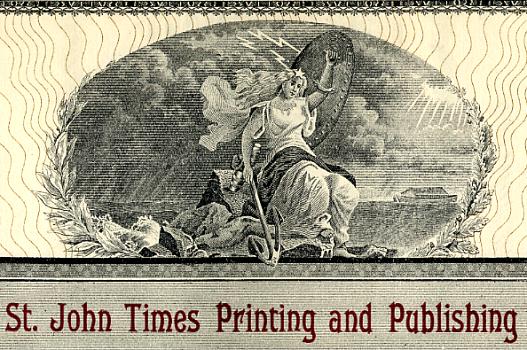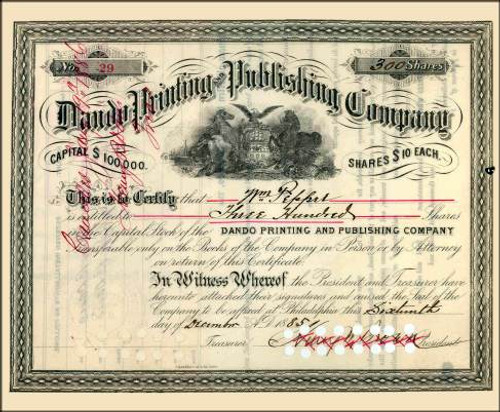Beautiful certificate from the St. John Times Printing and Publishing Company issued no later than 1923. This historic document has an ornate border around it with a vignette of a woman holding a shield protecting herself from lightning. This item has the signatures of the Company's President and Secretary and is over 83 years old. 
Certificate Vignette Newfoundland (French: Terre-Neuve; Irish: Talamh an Ãisc; Latin: Terra Nova) is a large island off the northeast coast of North America, and the most populous part of the Canadian province of Newfoundland and Labrador. The island of Newfoundland (originally called Terra Nova) was most likely first named by the Italian John Cabot (Giovanni Caboto) in 1497, which would make it the oldest European name in North America. The province where this island is located was also called Newfoundland up until 2001, when its name was changed to Newfoundland and Labrador (the postal abbreviation was simultaneously changed from NF to NL). Newfoundland is separated from the Labrador Peninsula by the Strait of Belle Isle and from Cape Breton Island by the Cabot Strait. It blocks the mouth of the Saint Lawrence River, creating the Gulf of Saint Lawrence, the world's largest estuary. Newfoundland's nearest neighbour is the small French overseas community of Saint-Pierre and Miquelon. It is 111,390 km2 in area, making it the world's 15th largest island. The provincial capital, St. John's, is found on the southeastern tip of the island. Cape Spear, just south of the capital, is Canada's easternmost point. The island of Newfoundland has an approximate population of 485,000. Newfoundland is pronounced by Newfoundlanders as new-fin-land or new-fun-land and take exception to it being pronounced with the last syllable slurred, (as new-found-l'nd). Newfoundland has a dialect of English known as Newfoundland English, a dialect of French known as Newfoundland French and a dialect of Irish known as Newfoundland Irish. Being one of the first places discovered in the New World, Newfoundland has a rich history. St. John's is considered to be the oldest city in English speaking North America. Newfoundland is home to two national parks. Gros Morne National Park is located on the west coast of Newfoundland and was named a UNESCO World Heritage site in 1987 due to its complex geology and remarkable scenery. It is the largest national park in Atlantic Canada at 1,805 km² (697 sq. mi.). Terra Nova National Park, on the island's east side, preserves the rugged geography of the Bonavista Bay region and allows visitors to explore the historic interplay of land, sea and man. Stephenville, a town of about 8000, once served as an airport base for the US army in the early 1940s. It is about 20 miles north of its former train station, which is surrounded by the town of Stephenville Crossing. Also on the West Coast, Corner Brook is situated in the Bay of Islands region. The major industry in Corner Brook is newsprint manufacturing, and is serviced by the Corner Brook Pulp and Paper Mill. Sandy Point, which is located in Bay Saint George and north of the town of St. George's, was the first and largest settlement of the west coast. However, the last settler, Alphonsus Swyers, was forced to abandon in 1973.
Since Bob and Susana Kerstein own a Newfy, we thought it is important to mention that Newfoundland, is also known for the wonderful dog named after this Province. Newfoundlands ("Newfies") have webbed feet and a water-resistant coat. Males weigh 60-70 kg (130-150 pounds), and females 45-55 kg (100-120 pounds), putting them in the "giant" weight range. Most Newfies are black, but brown, gray, Irish Spotted (black with white markings), and Landseer (black head, white body with black markings) varieties exist. The Landseer is named after the artist Sir Edwin Landseer, who featured them in many of his paintings. Some kennel clubs consider the Landseer to be a separate breed; others consider it simply a Newfoundland color variation. Some kennel clubs consider Irish Spotted to be an "invalid" marking, and will not allow them to be shown. The Newfoundland is similar in size, shape, and coat type to the Great Pyrenees, except that the Great Pyrenees is usually white and the Newfie is usually black. The Landseer Newfoundland and a Great Pyreness with dark patches on its coat are difficult for the layperson to distinguish.

Certificate Vignette
Since Bob and Susana Kerstein own a Newfy, we thought it is important to mention that Newfoundland, is also known for the wonderful dog named after this Province. Newfoundlands ("Newfies") have webbed feet and a water-resistant coat. Males weigh 60-70 kg (130-150 pounds), and females 45-55 kg (100-120 pounds), putting them in the "giant" weight range. Most Newfies are black, but brown, gray, Irish Spotted (black with white markings), and Landseer (black head, white body with black markings) varieties exist. The Landseer is named after the artist Sir Edwin Landseer, who featured them in many of his paintings. Some kennel clubs consider the Landseer to be a separate breed; others consider it simply a Newfoundland color variation. Some kennel clubs consider Irish Spotted to be an "invalid" marking, and will not allow them to be shown. The Newfoundland is similar in size, shape, and coat type to the Great Pyrenees, except that the Great Pyrenees is usually white and the Newfie is usually black. The Landseer Newfoundland and a Great Pyreness with dark patches on its coat are difficult for the layperson to distinguish.








